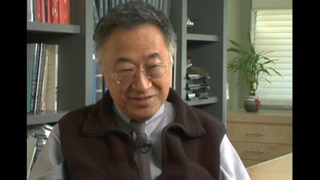Interviews
A Reporter’s Responsibility
Well, the fence was a very big issue. One of the main causes of resentment in the assembly centers was that they were all fenced in. And when they, these people first came to Heart Mountain, there was no fence surrounding the camp site. There was really no need for a fence. You could walk 20 miles through the sagebrush and not run into anything. And after the camp was pretty well settled, the army decided to put up a barbwire fence around the camp and put up watchtowers. ... As I recall, some of the camp leaders got -- organized a petition-signing campaign, as I recall. And they sent that on to the WRA.
And of course, this was important news. It had to be covered. And we did cover it with a -- it was the top story with a headline all the way across the top of page one. But at the same time, we had the responsibility of not stirring up the anger of the people so that there might be an incident. And that would've been very, very dangerous. So the paper had a responsibility to report the news without being provocative about it. And I think we managed to do that by playing the story right down the middle, the top story on page one. But we reported it objectively, and that satisfied the readership.
Date: July 13, 2001
Location: Washington, US
Interviewer: Alice Ito, Daryl Maeda
Contributed by: Denshō: The Japanese American Legacy Project.
Explore More Videos

Conditions at Pinedale Assembly Center
(b.1909) Nisei from Washington. Incarcerated at Tule Lake and Minidoka during WWII. Resettled in Chicago after WWII

Making craft items from shells found at Tule Lake
(b.1909) Nisei from Washington. Incarcerated at Tule Lake and Minidoka during WWII. Resettled in Chicago after WWII

Response to loyalty questionnaire
(b.1909) Nisei from Washington. Incarcerated at Tule Lake and Minidoka during WWII. Resettled in Chicago after WWII

Move from Tule Lake to Minidoka
(b.1909) Nisei from Washington. Incarcerated at Tule Lake and Minidoka during WWII. Resettled in Chicago after WWII

Apprehension about leaving camp
(b.1909) Nisei from Washington. Incarcerated at Tule Lake and Minidoka during WWII. Resettled in Chicago after WWII

442 soldiers visiting U.S. concentration camps
(b. 1924) Political scientist, educator, and administrator from Hawai`i

Receiving a negative reaction from father upon asking about World War II experience
(b. 1939) Japanese American painter, printmaker & professor

Loss of happy-go-lucky adolescence in Puyallup Assembly Center
(b. 1923) Nisei from Washington. Resisted draft during WWII.

Memories of dusty conditions at Minidoka incarceration camp
(b. 1923) Nisei from Washington. Resisted draft during WWII.

Making the decision to resist the draft
(b. 1923) Nisei from Washington. Resisted draft during WWII.

Social activities in Tashme
(b.1920) Japanese Canadian Nisei. Established the Ikenobo Ikebana Society of Toronto

Difference between experiences of youth and older people in WWII camps
(b.1929) Pioneer medical researcher in tissue transfer and organ transplantation.

Discharged from the U.S. Army after Pearl Harbor
(b. 1918) Founder Azumano Travel

Reaction to a 1942 speech by Mike Masaoka, Japanese American Citizen League's National Secretary
(1915 - 2011) Nisei florist who resettled in New York City after WW II. Active in Japanese American civil rights movement

Death of sister in October 1942
(1915 - 2011) Nisei florist who resettled in New York City after WW II. Active in Japanese American civil rights movement
